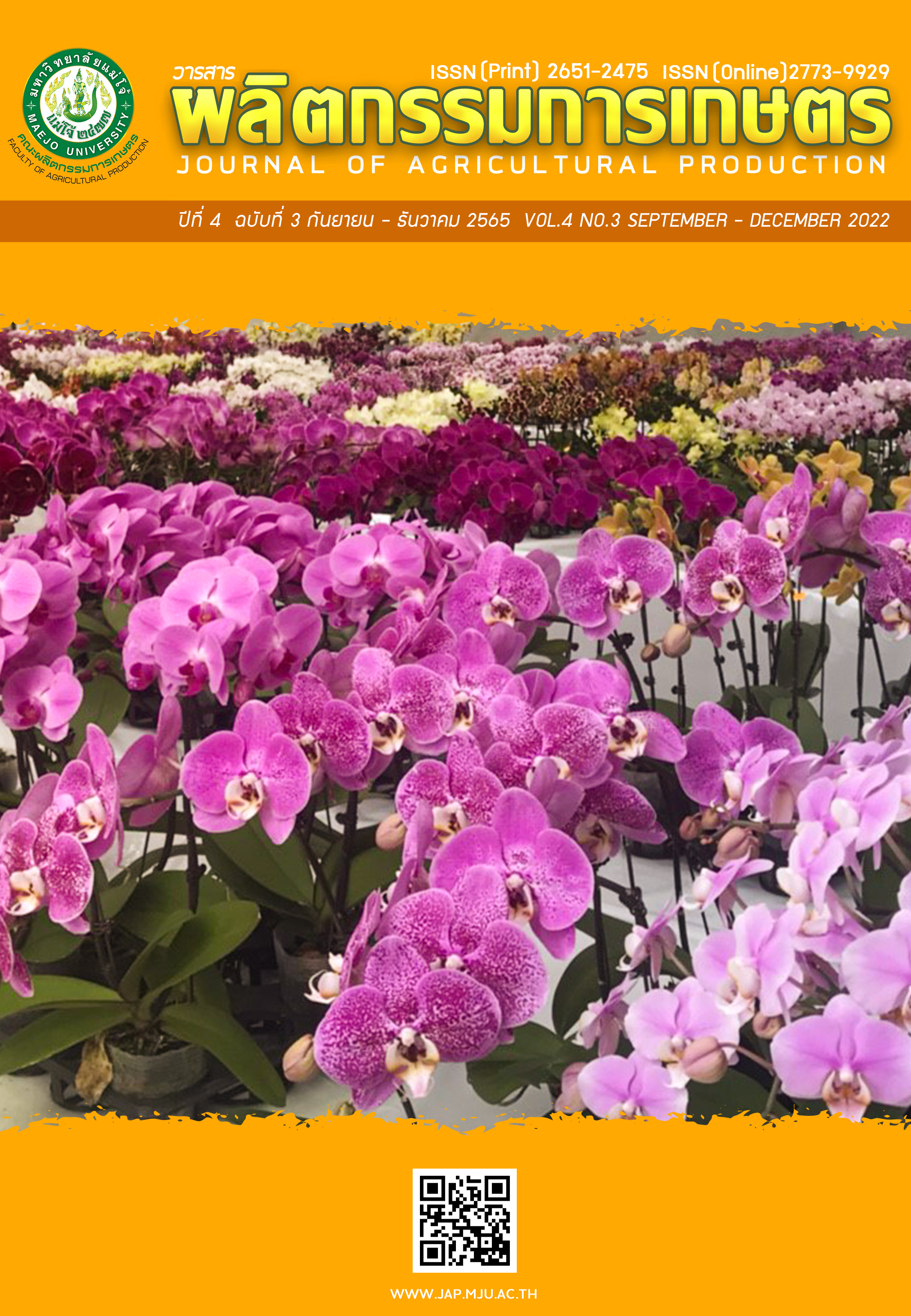ผลของสภาวะการอบต่อองค์ประกอบทางพฤกษเคมี ปริมาณ สารประกอบฟีนอลิกรวม และคุณสมบัติต้านอนุมูลอิสระในจิงจูฉ่าย
Main Article Content
บทคัดย่อ
งานวิจัยนี้ได้ศึกษาผลของความแตกต่างของสภาวะการอบ (อุณหภูมิ เท่ากับ 60, 70 และ 80 องศาเซลเซียส และเวลา 12 และ 24 ชั่วโมง) ในการอบแห้งจิงจูฉ่ายต่อสารพฤกษเคมี ปริมาณสารประกอบฟีนอลิกรวม และฤทธิ์ต้านอนุมูลอิสระ ผลการทดลองที่ได้แสดงให้เห็นว่าสภาวะการอบที่แตกต่างกันส่งผลให้สารพฤกษเคมี ปริมาณสารประกอบฟีนอลิกรวม และฤทธิ์ต้านอนุมูลอิสระ มีความแตกต่างอย่างมีนัยสำคัญ (P<0.05) โดยสารพฤกษเคมีที่พบในจิงจูฉ่ายคือ ฟลาโวนอยด์ คูมาริน แทนนิน เทอร์พีนอยด์ สเตอร์รอยด์ ซาโปนิน และคาร์ดิแอกไกลโคไซด์ นอกจากนี้ปริมาณของสารประกอบฟีนอลิกรวม (คิดเป็น 287.76 ไมโครกรัม สมมูลของกรดแกลลิกต่อตัวอย่างแห้ง 1 กรัม) และฤทธิ์การต้านอนุมูลอิสระโดยวิธีดีพีพีเอช และ เอบีทีเอช (มีค่าการยับยั้งร้อยละ 18.87 และ 30.10) มีค่าสูงที่สุดเมื่อทำการอบแห้งที่อุณหภูมิ 60 องศาเซลเซียส เป็นเวลา 12 ชั่วโมง การเพิ่มอุณหภูมิและเวลาในการอบแห้งส่งผลให้สารกลุ่มแทนนิน ปริมาณสารประกอบฟีนอลิกรวม และฤทธิ์ต้านอนุมูลอิสระ มีค่าลดลง ดังนั้น สภาวะที่เหมาะสมในการอบแห้งจิงจูฉ่ายจึงควรทำแห้งด้วยเตาอบลมร้อนที่อุณหภูมิ 60 องศาเซลเซียสและใช้เวลาในการอบแห้ง 12 ชั่วโมง
Article Details

อนุญาตภายใต้เงื่อนไข Creative Commons Attribution-NonCommercial-NoDerivatives 4.0 International License.
เอกสารอ้างอิง
กุลวดี แก้วก่า สุพัชชา ขับกล่อมส่ง และสุพีรยา อาษา. 2564. ผลของสภาวะการทำแห้งและระยะเวลาแช่ชาต่อปริมาณสารประกอบฟีนอลิกและฤทธิ์การต้าน สารอนุมูลอิสระของชากลีบบัว. วารสารเทคโนโลยีการอาหารมหาวิทยาลัยสยาม 16(1): 78-88.
เต็ม สมิตินันทน์. 2544. ชื่อพรรณไม้แห่งประเทศไทย. ส่วนพฤกษศาสตร์ป่าไม้ สำนักวิชาการป่าไม้ กรมป่าไม้, กรุงเทพฯ.
ทศพล วรรักษ์กุลวงศ์ และสุรวิช วงศ์สวัสดิ์เวช. 2555. ฤทธิ์ต้านการแบ่งตัวของเซลล์และฤทธิ์ต้านอนุมูลอิสระของสารสกัดสมุนไพรจิงจูฉ่าย. โครงการพิเศษปริญญาเภสัชศาสตรบัณฑิต ภาควิชาเภสัชวินิจฉัย, คณะเภสัชศาสตร์, มหาวิทยาลัยมหิดล.
พิริยะภรณ์ อภิชาตยานนท์. 2560. การศึกษาพฤกษเคมีและฤทธิ์ทางชีวภาพจากส่วนเหนือดินของจิงจูฉ่าย. วิทยานิพนธ์วิทยาศาสตรมหาบัณฑิต สาขาวิชาเคมีศึกษา, คณะวิทยาศาสตร์ มหาวิทยาลัยบูรพา.
มาตรฐานผลิตภัณฑ์ชุมชน 996/2556. 2556.สมุนไพรรวมแห้งชงดื่ม. แหล่งข้อมูล: https://tcps.tisi.go.th/pub/tcps0996_56(สมุนไพรรวมแห้งชงดื่ม).pdf (4 เมษายน 2565).
สำนักงานคณะกรรมการอาหารและยา. 2549. แนวทางการพิจารณาอาหารประเภทชาสมุนไพร. แหล่งข้อมูล: http://food.fda.moph.go.th/Rules/dataRules/3-HerbalTea.pdf (21 มกราคม 2565).
สุกัญญา จันทร์สุนะ ลลิตา เจริญทรัพย์ เยาวพา จิระเกียรติกุล และพรชัย หาระโคตร. 2563. ผลของอุณหภูมิและระยะเวลาการอบแห้งต่อปริมาณสารต้านอนุมูลอิสระและความ สามารถในการยับยั้งอนุมูลอิสระของใบบัวบก [Centella asiatica (L.) Urb.]. วารสารวิทยาศาสตร์และเทคโนโลยี 28(12): 2261-2272.
องค์การสวนพฤกษศาสตร์. 2560 แก้วเมืองจีน. แหล่งข้อมูล: http://www.qsbg.org/Database/Botanic_Book%20full%20option/search_detail.asp?botanic_id=2849 (21 มกราคม 2565).
Chew, Y.L., Y.Y. Lim, M. Omar and K.S. Khoo. 2008. Antioxidant activity of three edible seaweeds from two areas in South East Asia. J. Food Sci. Technol. 41(6): 1067-1072.
Flora Fauna Web. 2019. Artemisia lactiflora Wall. ex DC. Available: https://www.nparks.gov.sg/florafaunaweb/flora/1/6/1687 (September 18, 2021).
Hassan, S.W., R.A. Umar, H. M. Maishanu, I.K. Matazu, U.Z. Faruk and A.A. Sani. 2007. The Effect of Drying Method on the Nutrients and Non-nutrients Composition of Leaves of Gynandropsis gynandra (Capparaceae). Asian. J. Biochem. 2(5): 349-353.
Jeong, D.W., Y.K. Park, S.S. Nam and S.K. Han. 2015. Effect of hot-air drying temperature on antioxidative activity of sweetpotato leaves. Korean J. Food Preserv. 22(5): 708-713.
Jing, Z.W., Z. Su-ying and Y. Yuan-yi. 2011. Analysis of chemical components of volatile oil from Artemisia Lactiflora Wall in North Guizhou province of China. Medicinal Plant. 2(6): 59-61.
Karaalan, M., F.M. Yilmaz, O. Cesur, H. Vardin, A. Ikinci and A.C. Dalgic. 2014. Drying kinetics and thermal degradation of phenolic compounds and anthocyanins in pomegranate arils dried under vacuum conditions. J. Food Sci. Technol. 49(2): 595-605.
Kooltheat, N., K. Chujit, K. Nuangnong, N. Nokkaew, K. Bunlue, K. Yamasaki and M. Chatatikun. 2021. Artemisia lactiflora extracts prevent inflammatory responses of human macrophages stimulated with charcoal pyrolysis smoke. Journal of Evidence-Based Integrative Medicine. 26: 1-11.
Kwasniewska-Karolak, I. and R. Mostowski. 2021. Effect of different drying processes on an antioxidant potential of three species of the Lamiaceae family. Herba Pol. 67(1): 8-17.
Lin, F.D., D.W. Luo, J. Ye and M.T. Xiao. 2014. Chemical constituents of Artemisia lactiflora (II). China Journal of Chinese Materia Medica. 39(13): 2531-2535.
Minh, N.P., V.T. Pham, T.K. Hoa, V.T. Sang and L.T.S Na. 2019. Effect of blanching and drying to production of dried herbal tea from Pouzolzia zeylanica. J. Pharm. Sci. Res. 11(4):1437-1440.
Mohammed, S., M. Edna, and K. Siraj. 2020. The effect of traditional and improved solar drying methods on the sensory quality and nutritional composition of fruits: A case of mangoes and pineapples. Heliyon. 6(6): 1-10.
Nguyen, Q.V., B. Huyen, B. Thi, M.Đ. Tran, M.T. Nguyen, M.D. Doan, A.D. Nguyen, T.M. Le, V.C. Tran and T.N. Pham. 2020. Impact of different drying temperatures on in vitro antioxidant and antidiabetic activities and phenolic compounds of wild guava leaves collected in the central highland of Vietnam. Natural Product Communications. 17(4): 1-10.
Prommajak, T., S. Surawang and N. Rattanapanone. 2014. Ultrasonicassisted extraction of phenolic and antioxidative compounds from lizard tail (Houttuynia cordata Thunb.). Warasan Songkhla Nakharin. 36(1): 65-72.
Rabeta, M.S. and M. Vithyia. 2013. Effect of different drying methods on the antioxidant properties of Vitex negundo Linn. tea. Int. Food Res. J. 20(6): 3171-3176.
Saifullah, M., R. McCullum, A. McCluskey and Q. Vuong. 2019. Effects of different drying methods on extractable phenolic compounds and antioxidant properties from lemon myrtle dried leaves. Heliyon 5(12): 1-8.
Singh, R.P., K.N. Chidambara and G.K. Jayaprakasha. 2002. Studies on the activity of pomegranate (Punica granatum) peel and seed extracts using in vitro models. J. Agric. Food Chem. 50(1): 81-86.
Taufik, Y., T. Widiantara, and Y. Garbida. 2016. The effect of drying temperature on the antioxidant activity of black mulberry leaf tea (Morus nigra). Rasyan J. Chem. 9(4): 889-895.
Thaipong, K., U. Boonprakob, K. Crosby, L. Cisneros-Zevallos and D.H. Byrne. 2006. Comparison of ABTS, DPPH, FRAP and ORAC assays for estimating antioxidant activity from guava fruit extracts. J. Food Compost. Anal. 19: 669-675.
Ueda, Y., N. Apiphuwasukcharoen, S. Tsutsumi, Y. Matsuda, V. Areekul and S. Yasuda. 2019. Optimization of hotwater extraction of dried yacon herbal tea leaves: enhanced antioxidant activities and total phenolic content by response surface methodology. Food Sci. Technol. 25(1): 131.139.
Yi, W. and Y.H. Wetzstein. 2011. Effects of drying and extraction conditions on the biochemical activity of selected Herbs. HORTSCIENCE. 46(1): 70-73.


